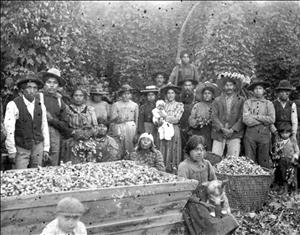In 1872 (some sources state 1869), Charles Carpenter brings hop root cuttings to the Yakima Valley and grows them on his homestead at Ahtanum near Moxee. The climate and soil prove perfect for the crop, and by 1930 Moxee City is known as the hops capital of the world.
The hops plant produces vines many yards long and is cultivated for its flowers. Hops flowers, when dried, are used in the beer brewing process to impart to the brew a slightly bitter flavor.
Hop vines are grown trellised to 12-foot poles. At the height of the growing season the vines can lengthen as much as six inches in 24 hours -- 25 feet in a season. A perennial plant, hops (Humulus lupulus) grow on rootstock which can continue to produce for many years.
When ripe they become deep yellow and crisp to the touch. The agreeably bitter quality hops supply to beer flavor is a product of its lupulin content. Hop flowers are at their most desirable when harvested fairly small and thin-leaved.
The rootstock Charles Carpenter used was from his father’s hop farm in Constable, New York. (New York still [2003] produces a small annual hops crop, as do California and Oregon.)
The 1890s saw a large influx of French Canadians into the Moxee area due to land promotions aimed toward them by the disbanding Moxie Company, a 6,400-acre farm that thrived briefly in the area. Many of these families chose to grow hops, which flourished in the region to such an extent that “hops” and “Moxee” became synonymous.
Harvesting hops, although tedious, was not overly arduous when compared to harvesting other crops. The hop harvest usually began in late August and lasted about six weeks. Plants were cut to three feet and the flower-heavy vines laid out for picking. Local farm families throughout the Yakima Valley supplemented their incomes by picking hops. Native American pickers also migrated to the region during the hops harvest: Sinkiuse, Sanpoil, and Coast Salish peoples joined the local Yakama tribes people. Often the women and children handled the bulk of the picking, working from sun-up to sunset. Evenings were spent playing games and visiting. The end of the harvest was celebrated with horse racing and friendly gambling games (“lahal”).
After the cone-shaped hop flowers were harvested they were spread onto burlap-covered slats on the second floor of hops barns (called kilns). Heat from a wood burning stove on the lower floor dried the hops in 24-hours. Hops flowers lose 70 percent of their green weight during drying.
Although Moxee City became most famous for hops production, hops were also cultivated throughout the Yakima Valley and in the Boisfort Valley near Chehalis. In time, Washington became the nation’s leading hops-producer. In 2003, 75 percent of the United States's supply of hops and 20 percent of the world’s supply are grown on 26,200 acres in Yakima and Benton counties, yielding a yearly harvest of 65 million pounds (Washington Hop Commission).

